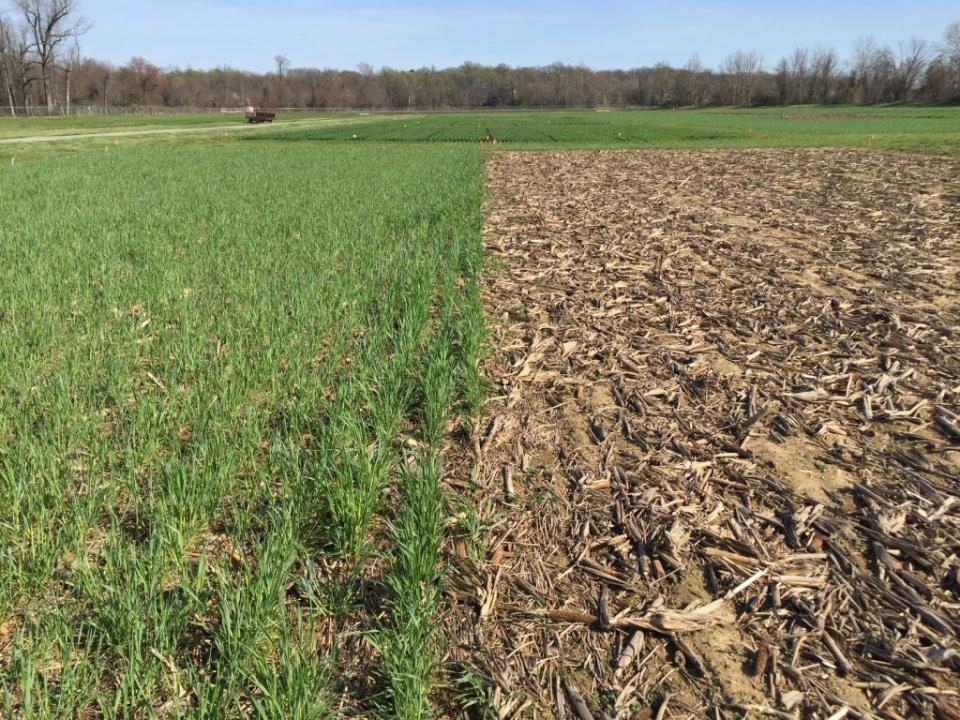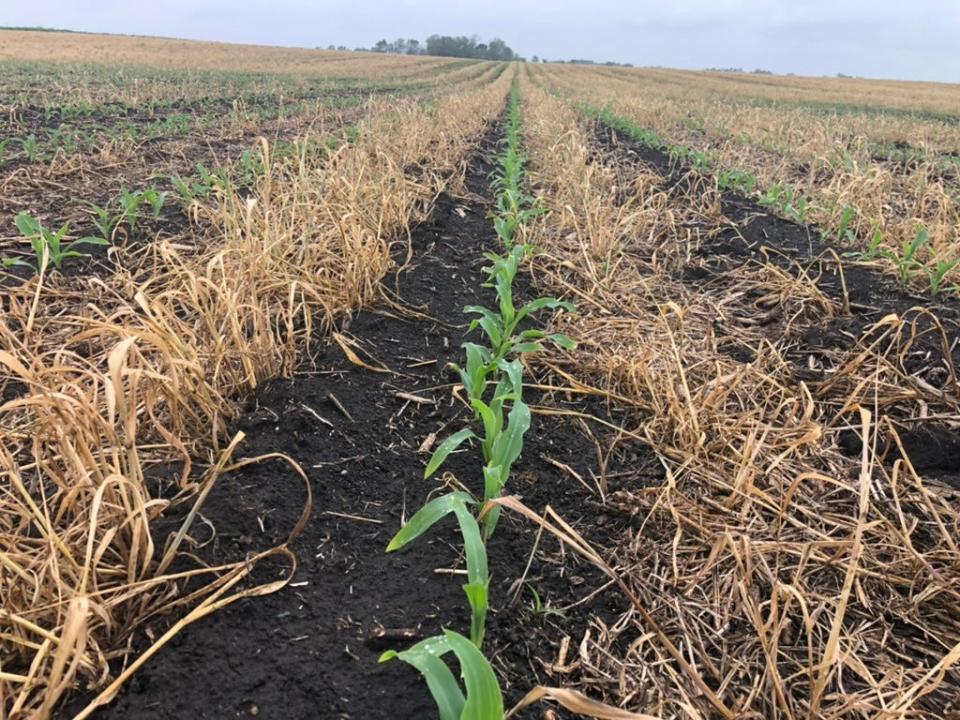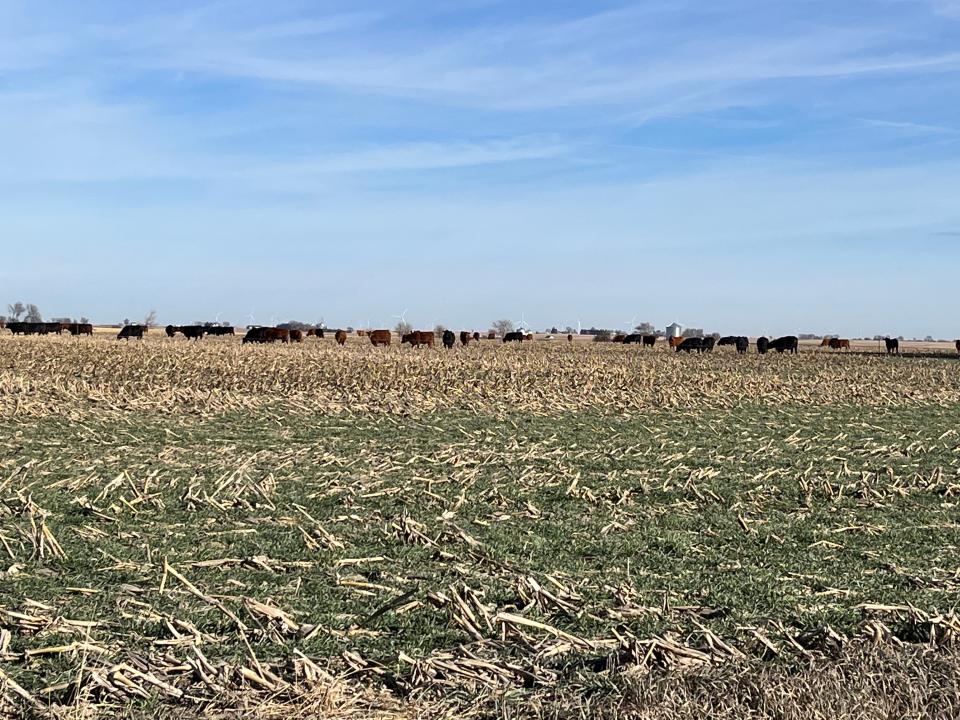Ancient farming practice makes a comeback as climate change puts pressure on crops

Fred Yoder in Ohio plants rye and winter peas he never harvests. Larkin Martin in Alabama plants radishes she’ll never eat. A.G. Kawamura in California plants barley that rots in the fields.
Each is part of a small but growing movement to bring back an ancient agricultural practice called cover cropping that was once used to rejuvenate soil but now also likely comes with the added benefits of mitigating climate change and protecting against its ravages.
It’s increasingly getting a push from Department of Agriculture programs and even companies that buy commodities. But mostly, farmers say it saves them money and protects their land.
“Our soils keep getting better and better. You take a shovel out and dig deep down and you see the earthworms and the absence of a hardpan. That soil is just mellow all the way through,” said Yoder, a fourth-generation family farmer in Plain City, Ohio.
How does climate change affect you?: Subscribe to the weekly Climate Point newsletter
READ MORE: Latest climate change news from USA TODAY
For him, planting rye in his fields after he has harvested his cash crops of corn and soybeans is no altruistic effort. It’s about economics and making his farm profitable.
“My biggest driver is trying to save money,” he said. “I’ve cut our fertilizer use by 20%, we’re skipping a herbicide application, and my fields hold more water.”
Cover cropping is no panacea to the many struggles farmers face as they operate within the razor-thin margins of agriculture. It can be costly – as much as $35 an acre – and takes several years to make a significant difference. It also requires new timing and sometimes new equipment and can increase pest infestations.
But after a few years, fields planted in cover crops store thousands more gallons of water than bare fields during torrential rains, resist weeds' encroachment more, hold together better against erosion, survive droughts better and capture more carbon in their soils.
Increasingly, farmers are turning to it as a way to protect against erratic weather and to decrease costs from chemical inputs. The hope, eventually, is that these climate-smart crop practices might get a premium in the marketplace, reimbursing farmers for the climate work their fields do for the nation by returning carbon to the soil.
Ten years ago, only about 10 million acres in the U.S. were planted with cover crops. Today that’s up to about 22 million acres, and the number is increasing by about 8% annually, said Rob Myers, director of the Center for Regenerative Agriculture at the University of Missouri.
A study last month by researchers at the University of Illinois found that in the Midwest, cover-cropped acreage increased fourfold from 2011 to 2021.
This heralds the return of a very old agricultural practice, Myers said. “George Washington and Thomas Jefferson would write letters to each other about what cover crops they were planting.”

What are cover crops?
“A cover crop is a plant used to protect and improve the soil, typically when no other plant is growing in the field,” said Myers, who has been studying sustainable farming methods for 20 years.
What’s planted varies, but it can include grains such as rye, barley and oats, vegetables such as radishes, and peas and nitrogen-fixing plants like crimson clover.
As soon as the cash crop, usually soybeans, corn, wheat or cotton, is harvested, the farmer plants the cover crop – often directly into the leftover stubble.
The cover crop grows just a few inches before winter comes and then goes dormant. In the spring it starts growing again while the fields are warming and drying before farmers plant. All that time it keeps weeds down by outcompeting them and helps the soil absorb heavy rains.
When it’s time to plant, the farmer kills off the cover crop, either by running a heavy “crimp roller” over it or spraying herbicide. The cash crop is then seeded straight into what to a traditional farming eye might look like a messy field.

But that litter of dry and rotting corn stalks, ryegrass, clover and radishes is actually creating amazing soil.
“If you have living roots in the soil year-round, that keeps feeding the soil microbes,” Myers said. “A teaspoon of soil, if it’s healthy, can have as many microbes as there are people on the planet Earth.”
Farmers have used cover crops for eons. The Romans planted beans in their vineyards to improve yields. But in the 1950s they came to be seen as no longer necessary as the U.S. shifted to new forms of farming.
“With cheap fertilizers, particularly nitrogen, having been developed as an offshoot of World War II efforts, cover crops were no longer viewed as necessary for improving soil fertility,” Myers said. “They definitely fell out of favor starting in the 1950s and continuing to decline through the early 1970s.”
CLIMATE CHANGE: Weird weather hit cattle ranchers and citrus growers in 2022. Why it likely will get worse.
CLEAN ENERGY: First offshore wind power sites auctioned off California's coast. One day it could power 1.5M homes.
Those new technologies were adopted because they worked. New chemical fertilizers, herbicides and insecticides along with constantly improving seed tripled U.S. agricultural output from 1948 to 2015 even as the labor required declined by 75% and land by 25%, according to the Economic Research Service of the Department of Agriculture.
Farmers who would have used the “green manure” of cover crops to bolster their soil instead poured on fertilizer and left fields bare for much of the year, fearful that any plants beyond the crops they wanted to grow would suck up water and nutrients.
The next big innovation in U.S agriculture came in the 1980s and '90s with no-till farming. It was a revolutionary agriculture technique that virtually ended tilling the soil. Farmers would spray a herbicide in the spring to cut down the weeds, then use specially designed seed drills to plant without plowing.
“All you’re doing is cutting a slot. The slot is about an inch wide; you’ve got a V in the back that closes it and puts dirt back on the seed,” said Yoder, who switched to no-till 30 years ago.
No-till works because genetically modified seeds for feed corn, soybeans, cotton and other crops can be sprayed with herbicides that don’t affect them. Today about 90% of these crops are GMO, or genetically modified, and when the USDA did its last agricultural survey, it found that 37% of U.S. farm acreage uses no-till farming, most of it in the Northeast, the mid-Atlantic states and the Midwest.
That helped with erosion and soil retention. But increasingly erratic weather, including torrential rains and longer dry periods, have made farmers realize more resiliency was needed.
Also, chemical runoff from overfertilized, conventionally farmed fields began to cause dead zones in the Gulf of Mexico and large bodies of water when excess fertilizer was washed out of fields and into rivers and streams.
It wasn’t until around 2010 that cover crops began trending nationally, though some areas got on the cover crop bandwagon earlier, including Maryland, because of concerns about water quality in the Chesapeake Bay during the 1990s.
Agronomists began to realize that modern postwar practices hurt soil ecosystems. They looked for ways to mimic conditions when the Midwest was covered in prairies, Myers said. Those were soils that had living roots in them all year that supported a complex system of soil microbes, bacteria, fungi and nematodes.
Without cover crops, the microbes in farm soil died out in fall and winter, meaning there were fewer nutrients to give crops and less structure to hold water.

Cover crops create climate change resilience
Cover cropping is a rare practice that worked in the past, works especially well now amid climate change's effects, and will help prevent climate change from worsening, said the USDA’s Farm Production and Conservation Undersecretary Robert Bonnie.
“We’re conditioned to think about environmental issues where you’ve always got conflicts, but in this case, you’ve got alignments,” he said.
The rewards of cover cropping are numerous, farmers say. The soil has more organic matter, so it requires less fertilizer. It also has channels where the roots of the cover crop have rotted away, along with those made by earthworms, that allow water to infiltrate deep in the soil rather than running off the top.
In California, Kawamura’s family runs Orange County Produce. They take over “ugly, abandoned pieces of ground where nothing wants to grow,” he said
These fields often have bare ground so compacted it's like cement. Workers plow it once to open up the soil, then plant cover crops with deep, penetrating roots like radishes or mustards or barley.
“We’re able to turn them around in three years,” he said. Those fields go on to the Kawamura’s signature crop, a wide variety of green beans that includes Blue Lakes, Yellow Wax, Romano, Purple and Kentucky Wonder.
“Good soil makes a farmer look good,” he said.
For Ray Gaesser, the changes in his soil are helping as climate change shifts weather patterns to heavier, more intense rainfall.
More: Extreme weather reveals a stunning shift in the way rain falls in America.
He has farmed in Corning, Iowa, for 45 years. “We have never seen 4 inches of rain in an hour before, but that’s what we got in 2010. In the six years after that, we had at least one of those every year.”
He put in waterways and terraces and drains in the fields and thought he was doing a good job of protecting the soil.
“But when you get 4 inches of rain in an hour, you can’t build a big enough terrace. The water just washes everything away,” he said.
Since he started planting cover crops, he has seen “huge benefits.”
When the soil was tested, the results found it absorbed an inch of water in 2 to 3 seconds. "When we went a half mile away, to the next farm over which had a recent history of tillage, it took 7 to 8 minutes to absorb that inch of water."

Building up the soil
For any farmer who has done mainstream agriculture, planting cover crops is something of a leap of faith. Residue from the cover crops builds up on the soil at first and neighbors look askance.
“My neighbor next to me, he’s 90 years old and he thinks I’m nuts,” said Yoder.
It’s not a neat and tidy sight the first couple of years. Beginning with cover crops can be a nail-biter for farmers who have been trained to prize nice, clean, well-tilled black fields.
Instead, they’re seeing a lot of stubble and crop residue build up in their fields and not necessarily breaking down quickly. But as the microbes and the worms come back, all that residue just melds back into the soil, said Mitchell Hora, a seventh-generation farmer in Iowa. His family farm began planting cover crops in 2013.
“Over time, your systems start working better, your soil’s in better shape, and now we’re rocking and rolling.” Hora said.
This year his area was "super-dry," but he still had above-average soybean yields. The organic matter the rye left on his fields is "the armor for now for our soil. It’s basically a sponge.”
Research data shows that for every percentage of organic matter in soil, an acre can hold 25,000 more gallons of water.
Hora has been so impressed with the change in his fields that he launched a consulting company, Continuum Ag, to help coach other farmers as they make the shift.

Cover crops aren't a silver bullet
After seven generations of farming in Alabama, Martin’s family has seen a lot happen in agriculture. She now has 7,000 acres of cotton, soybeans and corn and has worked hard to build up what she’s honest in describing as degraded soil.
“All the plowing that took place during the 20th century, it loosened up the soil so the roots could grow, but it caused an awful lot of erosion,” she said.
For her farm, no-till was a game-changer, and cover cropping adds further resiliency on top of that – but it’s not a magic bullet.
“It’s not perfect,” she said. It’s both an added expense and more trips across her fields, which means getting the economics right is key. “I wouldn’t call it profitable. I’d say cost-effective.
“And now we have slugs, which we didn’t have before,” she said. “On balance it’s positive, but it’s a new set of problems to solve.”
There are also open questions about whether cover cropping could lower yields. Some studies have found that for corn and soybeans it can, depending on field management. That could be offset by greater resiliency during droughts or intense rains but requires further study, scientists say.

USDA working to get farmers to try cover crops
The Department of Agriculture is encouraging farmers to try cover crops through various incentive programs. This isn’t something that can be done by regulations; it has to make sense for farmers economically, said Farm Production and Conservation Undersecretary Bonnie.
In September the agency rolled out $2.8 billion toward supporting climate-smart farming, some of which will go to cover crop support. There’s also a $5-an-acre rebate for farmers using cover crops off their crop insurance.
It’s part of “de-risking” the shift. “At the end of the day, these practices are all going to have to pencil out for the farmer,” Bonnie said.
USDA efforts such as Environmental Quality Incentives Program and the Conservation Stewardship Program have increased farmer participation in cover cropping. Researchers in Illinois found a strong correlation between such funding and adoption of the practice.
The payments only last for a few years and are meant to be enough to tip farmers over into giving it a try, not underwriting the entire cost.
“We're not going to subsidize everything. But the first year, we're offering to pay $25 an acre. Second year, $15 an acre. Third year, $10 an acre,” said John Johnson, a farmer and coordinator at Farmers for Soil Health, a newly-created partnership between soybean, corn and pork groups to encourage farmer-led cover crop programs. The group will be giving grants to farmers to try cover crops.
The hope is that the benefits to the farmers, and the climate, will be big.
“If we’re going to make a significant gain on the agricultural side, and we can, there’s a lot of opportunities for us to reduce greenhouse gas emissions,” Bonnie said.

Someday, farmers might be paid to store carbon
The hope is that someday farmers will be paid for the work of creating more robust soils that sequester larger amounts of carbon in them as a way to combat climate change.
But large-scale data on cover crops and carbon sequestration is lacking and more research is needed, scientists say. Some research has found large amounts of carbon being sequestered, while others have found less.
Though some companies have already begun to offer farmers a few dollars an acre for their efforts, the system is still in its earliest – and unregulated – days.
“Carbon is like the Wild, Wild West right now in agriculture,” Johnson said.
Being able to prove that a given farmer or a given field has taken a certain amount of carbon out of the atmosphere and put it back into the soil isn’t easy and isn’t cheap, but eventually it should be possible, experts say.
“The big, hairy, audacious goal” is that farmers will be able to sell, at a premium, crops they grow with sustainable and carbon-fixing practices said Grey Montgomery, who heads agricultural products and operations for DTN, a data and technology firm in Minnesota.. That will mean on-farm visits, satellite tracking, and soil testing and probes.
“It’s all going to be about measurement, reporting and verification,” he said.
In Alabama, Martin just wants to make her farm a little more resilient, a little more profitable and a little better every year. Over the past few years she has seen more of her neighbors plant cover crops in the winter.
“We drive along and look at somebody else’s fields and think, ‘Hm, I wonder what they planted this year?’”
It has become a big conversation in her area, at least for those putting their toes in the water, she said. “The ones that think we’re crazy, they don’t tell me.”
This article originally appeared on USA TODAY: Cover crops can help fight climate change effects on US farms
Solve the daily Crossword

